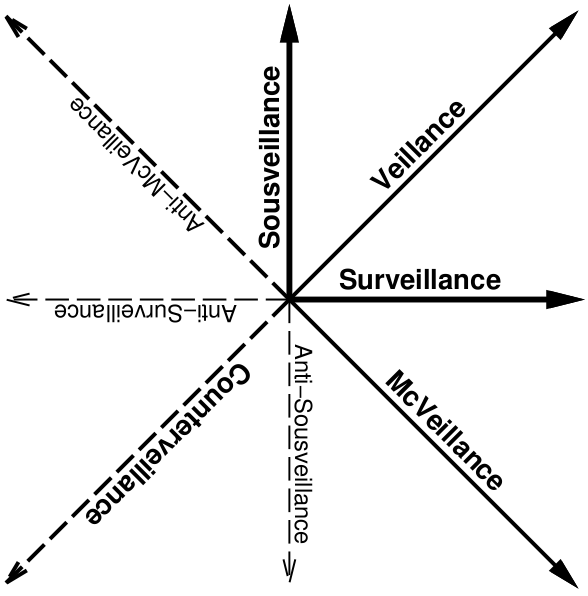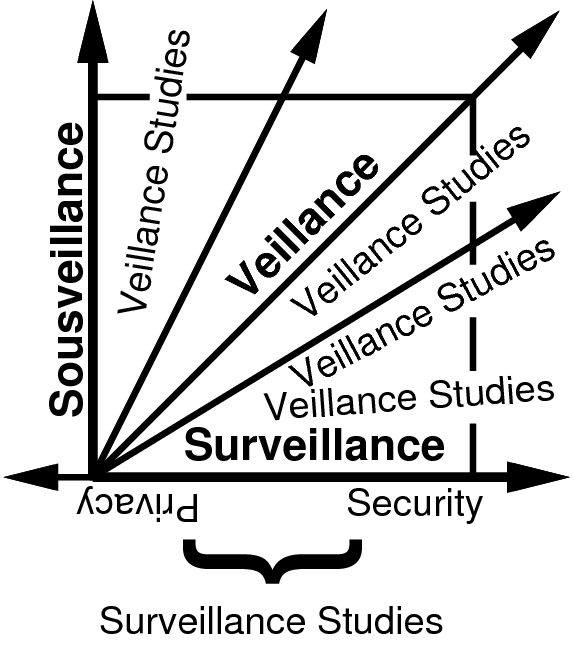The Sousveillance Scenarios
Steve Mann, 2012 October 22
Presented to at:
"Identity, Privacy & Security by ReDesign",
Monday 2012 October 22nd, 4pm to 5:30pm,
Room 728, Bissell building, 140 St. George Street
The class was given this file as "sousnario.txt" (plain text)
Introduction to concept of DASTEM (Design+Art + Science+Technology+Engineering+Mathematics as a unified "discipline"; discipline versus passion, etc.),
general discussion...
One can be in favour of more surveillance (safety) or less surveillance
(privacy), or one can be merely conducting studies,
in an allegedly objective manner as "surveillance studies".
But in all 3 cases, one would be against sousveillance.
All three approaches are part of the problem: considering only
one side of the argument (one side of the square box below).
Those who only consider the surveillance side of the space are
inherently biased, i.e. looking at the world from a one-sided
point-of-view. We must consider all the veillances, i.e. various
combinations of surveillance and sousveillance:
 .
.
 .
.
The topic of discussion for today's presentation
is sousveillance by way of four scenarios which we will discuss and
build upon:
Sousveillance Scenario A
Allan, a blind man, has an EyeBorg Implantable Camera System
(Canadian Patent 2313693).
It transmits live video to the "Seeing-Eye People" collective
comprised of friends, relatives, and volunteers who take turns to help him see
by remotely viewing his video and talking in his telephone earpiece to describe
what's in his environment.
His wife is confined to a hospital bed and unable to walk, but enjoys "walking"
by seeing through his eyes as he walks around the neighbourhood.
Questions:
Suppose as in the last sentence above, that Al's body is male,
but his vision and seeing is female (his wife).
Suppose Al is walking through the park one day, and needs to use the toilet.
- A1. Which washroom (Men or Women) should he use?
- A2. An opportunist robber recognizes that Al is blind, and decides to attack
and rob him. His wife records the encounter. Other less extreme incidents
have also been captured, so as to help Al see and understand the world around
him. Does Al have a moral, ethical, or legal duty to let people like the
robber, and others, know that they are being video recorded?
- A3. After a number of years practice seeing this way,
and sometimes with the help of a new computer-based
Artificial/Humanistic Intelligence system, Al can "recognize" faces of his
co-workers, and get around quite independently. Many people don't even know
that he is completely blind.
Should he notify these coworkers, or anyone else, that he is a camera?
- A4. Al decides, for moral and ethical reasons, to make it known that he
is a camera. He installs a small lapel pin miniature television screen
that displays video from his eye, with a small sign analogous to the
television screen at the entrance to a department store where you see
yourself on TV as you walk in.
Subsequently Al is physically assaulted by staff at a fast food restaurant
because they don't want a cameras in their business establishment.
They argue that since it is their property, they can make up whatever
rules they want on their property.
Al is met with similar treatment at other places such as
a large public art gallery where security guards push him down the
stairs and claim he was violating copyright.
Al realizes that all of this harrassment stops when he switches off the
television display but keeps the camera running as usual.
Al tries to contact the restaurant owner and gallery director, but neither
respond to him.
Should he take legal action against them in order to win the right to
openly use a camera? Or, pragmatically, should he simply go back to his
original "don't ask, don't tell" approach of keeping the camera hidden.
If he decides to be a crusader for the right to openly use his camera
(i.e. for the right to wear a television display that shows the output of
the otherwise hidden camera),
who should bear the cost (legal, etc.) of him doing so?
- A5. How can the wrongs committed against Al be redressed?
Consider swollag.
Sousveillance Scenario B:
Bo wears "Glass", otherwise known as "Digital Eye Glass" (EyeTap) to help
her see better. The Glass does not record. It simply captures video
at different exposures (dark, medium, light) in rapid succession and
CEMENTs them together for dynamic range management. Originally Bo only
wore the Glass while doing high dynamic range activities like welding,
but discovered Glass helped her see in many other situations.
Bo was physically assaulted on various occasions for wearing Glass.
Bo was physically assaulted by a security guard at a local art gallery
because he was afraid she was violating copyright. The guard pushed her
down the stairs and told her she was not welcome in the gallery.
When she spoke to the gallery director, he said that she was welcome in
the gallery as long as the Glass did not record anything.
Bo's lawyer advised her to record all encounters if possible, to use as
evidence in court against people who broke the law (either assault laws
or human rights laws broken by those treating her differently than others).
- B1. Should Bo follow her lawyer's advice?
- B2. Discuss in terms of swollag (action outside the domain of internal
investigation, for example).
Sousveillance Scenario C
Cy noticed her company often used video-oral contracts rather than written
contracts. Normally both parties get a copy of a written contract or it is
not enforcable. But her company had a rule forbidding cameras, while they
used surveillance cameras themselves. They refused to give her a copy of
the video in which she appeared, but they regularly made verbal contracts
with her, while recording their copy of the conversation for possible use
in court.
- C1. Should Cy break company rules and hide a camera to record her copy of
the contract?
- C2. If 2 parties make a contract and only 1 is allowed a copy, is the
contract valid?
- C3. Life-in-general is a "social contract" of sorts. Discuss this in terms
of sousveillance versus surveillance and in particular in terms of McVeillance.
- C4. Discuss in terms of swollag, e.g. action outside the company.
Sousveillance Scenario D
Di is involed in a car accident in a McDonalds parking lot. She was not
at fault. The Manager of the McDonalds was driving a car that struck her
car. When she stepped out to photograph the accident scene, the McDonalds
manager told her that photography is prohibited on McDonalds property.
He physically assaulted her when she tried to photograph the accident scene,
claiming that McDonalds is private property and she was bound by the rules
while on private property.
- D1. Discuss in terms of McVeillance theory.
- D2. Consider other scenarios like fire exits chained shut and civic
duty to report safety violations.
- D3. Discuss in terms of swollag.
Swollag
Swollag is that which gives sousveillance efficacy. Surveillance, by its very
nature, is associated with the efficacy of the usually large organizations that
bring it on. For example, surveillance benefits from the "guns,
gaols, and gallows" of the state. But sousveillance, being typically
"crowdsourced" requires a similar mechanism. Sometimes, for example, the
swollag comes from social networking and the "court of public opinion".
Each sousveillance scenario should be discussed in terms of swollag.
 .
.
 .
.